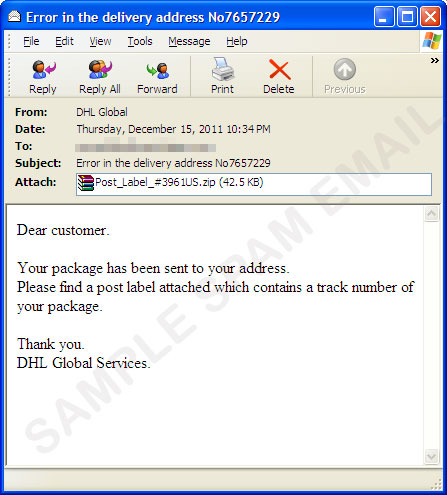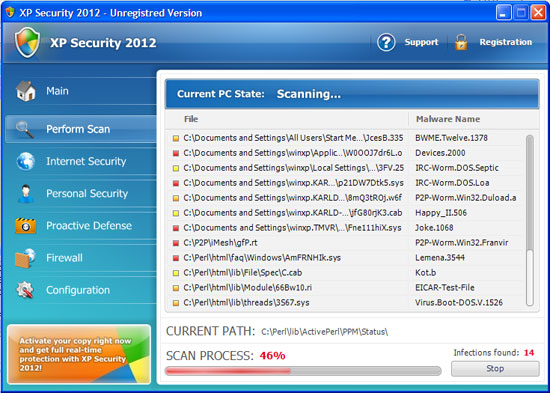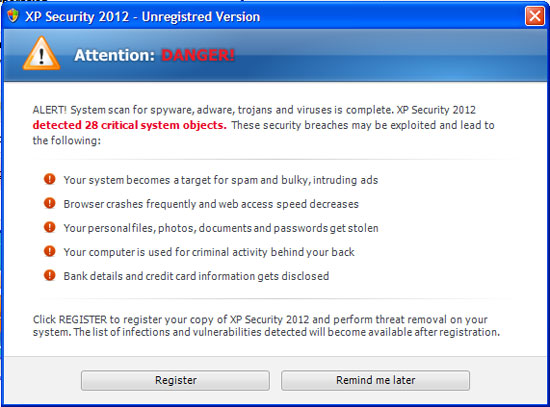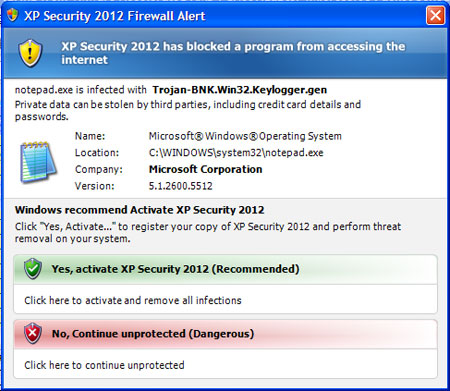TROJ_FAKEAV.ESY
Windows 2000, Windows, XP, Windows Server 2003


Threat Type: Trojan
Destructiveness: No
Encrypted:
In the wild: Yes
OVERVIEW
This Trojan arrives as an attachment to email messages spammed by other malware/grayware or malicious users. It may be unknowingly downloaded by a user while visiting malicious websites.
It connects to certain websites to send and receive information.
It installs a fake antivirus/antispyware software. It displays fake alerts that warn users of infection. It also displays fake scanning results of the affected system. It then asks for users to purchase it once scanning is completed. If users decide to purchase the rogue product, users are directed to a certain website asking for sensitive information, such as credit card numbers. When users agree to buy the software, it connects to a certain URL.
TECHNICAL DETAILS
Arrival Details
This Trojan arrives as an attachment to email messages spammed by other malware/grayware or malicious users.
It may be unknowingly downloaded by a user while visiting malicious websites.
Installation
This Trojan drops the following copies of itself into the affected system:
- %Application Data%\{three random characters}.exe
(Note: %Application Data% is the current user's Application Data folder, which is usually C:\Windows\Profiles\{user name}\Application Data on Windows 98 and ME, C:\WINNT\Profiles\{user name}\Application Data on Windows NT, and C:\Documents and Settings\{user name}\Local Settings\Application Data on Windows 2000, XP, and Server 2003.)
It drops the following file(s)/component(s):
- %Application Data%\2mib87egb1c6o3
- %User Temp%\2mib87egb1c6o3
- %System Root%\Documents and Settings\All Users\Application Data%\2mib87egb1c6o3
(Note: %Application Data% is the current user's Application Data folder, which is usually C:\Windows\Profiles\{user name}\Application Data on Windows 98 and ME, C:\WINNT\Profiles\{user name}\Application Data on Windows NT, and C:\Documents and Settings\{user name}\Local Settings\Application Data on Windows 2000, XP, and Server 2003.. %User Temp% is the current user's Temp folder, which is usually C:\Documents and Settings\{user name}\Local Settings\Temp on Windows 2000, XP, and Server 2003.. %System Root% is the root folder, which is usually C:\. It is also where the operating system is located.)
Autostart Technique
This Trojan adds the following registry entries to enable its automatic execution at every system startup:
HKEY_CURRENT_USER\Software\Microsoft\
Windows\CurrentVersion\Run
{random numbers} = %Application Data%\{malware file name}.exe
Other System Modifications
This Trojan adds the following registry keys:
HKEY_CLASSES_ROOT\.exe\DefaultIcon
HKEY_CLASSES_ROOT\.exe\shell
HKEY_CLASSES_ROOT\.exe\shell\
open
HKEY_CLASSES_ROOT\.exe\shell\
open\command
HKEY_CLASSES_ROOT\.exe\shell\
runas
HKEY_CLASSES_ROOT\.exe\shell\
runas\command
It adds the following registry entries:
HKEY_CLASSES_ROOT\.exe\DefaultIcon
(default) = %1
HKEY_CLASSES_ROOT\.exe\shell\
open\command
(default) = {malware path and file name} -a "%1" %*
HKEY_CLASSES_ROOT\.exe\shell\
open\command
IsolatedCommand = "%1" %*
HKEY_CLASSES_ROOT\.exe\shell\
runas\command
(default) = "%1" %*
HKEY_CLASSES_ROOT\.exe\shell\
runas\command
IsolatedCommand = "%1" %*
HKEY_CLASSES_ROOT\exefile
Content Type = application/x-msdownload
HKEY_CLASSES_ROOT\exefile\shell\
open\command
IsolatedCommand = "%1" %*
HKEY_LOCAL_MACHINE\SYSTEM\CurrentControlSet\
Services\SharedAccess\Parameters\
FirewallPolicy\DomainProfile
EnableFirewall = "0"
HKEY_LOCAL_MACHINE\SYSTEM\CurrentControlSet\
Services\SharedAccess\Parameters\
FirewallPolicy\DomainProfile
DoNotAllowExceptions = "0"
HKEY_LOCAL_MACHINE\SYSTEM\CurrentControlSet\
Services\SharedAccess\Parameters\
FirewallPolicy\DomainProfile
DisableNotifications = "1"
It modifies the following registry entries:
HKEY_LOCAL_MACHINE\SOFTWARE\Microsoft\
Security Center
AntiVirusDisableNotify = "1"
(Note: The default value data of the said registry entry is 0.)
HKEY_LOCAL_MACHINE\SOFTWARE\Microsoft\
Security Center
FirewallDisableNotify = "1"
(Note: The default value data of the said registry entry is 0.)
HKEY_LOCAL_MACHINE\SOFTWARE\Microsoft\
Security Center
UpdatesDisableNotify = "1"
(Note: The default value data of the said registry entry is 0.)
HKEY_LOCAL_MACHINE\SOFTWARE\Microsoft\
Security Center
AntiVirusOverride = "1"
(Note: The default value data of the said registry entry is 0.)
HKEY_LOCAL_MACHINE\SOFTWARE\Microsoft\
Security Center
FirewallOverride = "1"
(Note: The default value data of the said registry entry is 0.)
HKEY_LOCAL_MACHINE\SYSTEM\CurrentControlSet\
Services\SharedAccess\Parameters\
FirewallPolicy\StandardProfile
EnableFirewall = "0"
(Note: The default value data of the said registry entry is 1.)
HKEY_LOCAL_MACHINE\SYSTEM\CurrentControlSet\
Services\SharedAccess\Parameters\
FirewallPolicy\StandardProfile
DisableNotifications = "1"
(Note: The default value data of the said registry entry is 0.)
HKEY_CLASSES_ROOT\exefile\shell\
open\command
(default) = {malware path and file name} -a "%1" %*
(Note: The default value data of the said registry entry is "%1" %*.)
It deletes the following registry keys:
HKEY_LOCAL_MACHINE\SYSTEM\CurrentControlSet\
Services\wuauserv
Other Details
This Trojan connects to the following website to send and receive information:
- {BLOCKED}atohov.com
- {BLOCKED}gove.com
- {BLOCKED}fykylic.com
- {BLOCKED}kiduzega.com
- {BLOCKED}ovyhana.com
- {BLOCKED}gove.com
- {BLOCKED}idal.com
- {BLOCKED}abamimo.com
- {BLOCKED}urinaje.com
- {BLOCKED}zeficu.com
- {BLOCKED}udetewyny.com
- {BLOCKED}ajyqak.com
- {BLOCKED}jykok.com
- {BLOCKED}bakuxak.com
- {BLOCKED}jaw.com
- {BLOCKED}azumup.com
Rogue Antivirus Routine
This Trojan displays the following fake alerts:
It installs a fake antivirus/antispyware software.
It displays fake alerts that warn users of infection. It also displays fake scanning results of the affected system. It then asks for users to purchase it once scanning is completed. If users decide to purchase the rogue product, users are directed to a certain website asking for sensitive information, such as credit card numbers.
When users agree to buy the software, it connects to the following URL to continue the purchase:
- http://{BLOCKED}ogove.com/buy.html
NOTES:
Here is the screenshot of the spam sample:

SOLUTION
Step 1
For Windows XP and Windows Server 2003 users, before doing any scans, please make sure you disable System Restore to allow full scanning of your computer.
Step 2
Identify and terminate files detected as TROJ_FAKEAV.ESY
- If the detected file is displayed in either Windows Task Manager or Process Explorer but you cannot delete it, restart your computer in safe mode. To do this, refer to this link for the complete steps.
- If the detected file is not displayed in either Windows Task Manager or Process Explorer, continue doing the next steps.
Step 3
Restore modified and/or deleted registry value/s using this VBScirpt
To restore the modified and/or deleted registry value/s:
- Open Notepad.
» For Windows 2000, Windows XP, and Windows Server 2003 users, click Start>Run. In the Open input box, type notepad then press Enter.
» For Windows Vista and Windows 7 users, click Start, type notepad in the Search input field then press Enter. - Copy and paste the following script:
- Save this file as C:\RESTORE.VBS.
- Run C:\RESTORE.VBS.
» For Windows 2000, XP, and Server 2003 users, click Start>Run. In the Open input box, type C:\RESTORE.VBS then press Enter.
» For Windows Vista and Windows 7 users, click Start, type C:\RESTORE.VBS in the Search input field then press Enter.
Step 4
Delete this registry value
Important: Editing the Windows Registry incorrectly can lead to irreversible system malfunction. Please do this step only if you know how or you can ask assistance from your system administrator. Else, check this Microsoft article first before modifying your computer's registry.
- In HKEY_CURRENT_USER\Software\Microsoft\Windows\CurrentVersion\Run
- {random numbers} = %Application Data%\{malware file name}.exe
- {random numbers} = %Application Data%\{malware file name}.exe
Step 5
Search and delete these files
- %Application Data%\2mib87egb1c6o3
- %User Temp%\2mib87egb1c6o3
- %System Root%\Documents and Settings\All Users\Application Data%\2mib87egb1c6o3
Step 6
Scan your computer with your Trend Micro product to delete files detected as TROJ_FAKEAV.ESY. If the detected files have already been cleaned, deleted, or quarantined by your Trend Micro product, no further step is required. You may opt to simply delete the quarantined files. Please check this Knowledge Base page for more information.
Did this description help? Tell us how we did.





